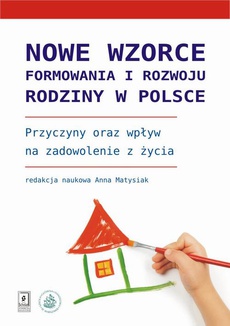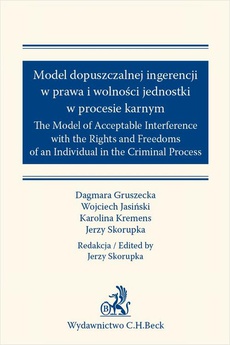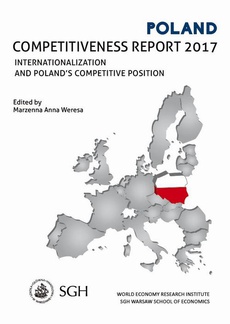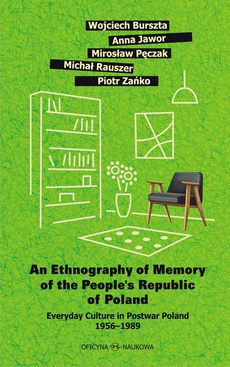INNE EBOOKI AUTORA

-14%
Individual Fertility Choices in Poland
Autor:
Format:
Książka obejmuje zagadnienia związane z podejmowaniem decyzji o rodzicielstwie. W całości w jęz. angielskim.
What are the processes contributing to individual reproductive choices, which, at the macro level, are reflected in the substantial drop in birth rates in the current context? How are these choices experienced and justified by young Poles?
| Rok wydania | 2009 |
|---|---|
| Liczba stron | 213 |
| Kategoria | Psychologia ogólna |
| Wydawca | Wydawnictwo Uniwersytetu Kardynała Stefana Wyszyńskiego |
| ISBN-13 | 978-83-7072-619-5 |
| Numer wydania | 1 |
| Język publikacji | polski |
| Informacja o sprzedawcy | ePWN sp. z o.o. |
POLECAMY
Ciekawe propozycje
Poland Can Into Space
do koszyka
Poland Competitiveness Report 2017....
do koszyka
Poland–Japan. Contemporary Art and...
do koszyka
Spis treści
| Acknowledgements | 9 |
| Chapter 1: Introduction | 11 |
| 1.1. Background of the study and research aims | 11 |
| 1.2. Outline of the book | 16 |
| Chapter 2: The Polish Case | 19 |
| 2.1. Fertility patterns in Poland | 20 |
| 2.1.1. Fertility | 20 |
| 2.1.2. Nuptiality and childbearing | 23 |
| 2.1.3. A note on migration | 24 |
| 2.1.4. Summary | 25 |
| 2.2. Context I: The ever-changing economic and institutional landscape | 26 |
| 2.2.1. From a centrally planned to a free market economy | 26 |
| 2.2.2. Unemployment | 27 |
| 2.2.3. Material situation of Poles | 29 |
| 2.2.4. Importance of human capital: Education | 30 |
| 2.2.5. Women in the labour market | 31 |
| 2.2.6. Provision of childcare | 33 |
| 2.3. Context II: The cultural heritage | 34 |
| 2.3.1. The Catholic Church | 35 |
| 2.3.2. Strong family | 35 |
| 2.3.3. Attitudes towards marriage and gender roles | 36 |
| 2.3.4. Contraception and abortion | 37 |
| 2.4. Summary | 39 |
| Chapter 3: Theoretical Approaches to Fertility Decline | 41 |
| 3.1. Theories of low fertility | 41 |
| 3.1.1. Demographic transitions and post-materialistic values theory | 41 |
| 3.1.2. Gender Equity Theory | 43 |
| 3.1.3. Globalisation and uncertainty theory | 44 |
| 3.1.4. Going micro: combining sub-narratives | 45 |
| 3.2. Individual behaviour: fertility choices | 50 |
| 3.2.1. Microeconomic approach | 50 |
| 3.2.2. Socio-psychological approach: Theory of Planned Behaviour | 53 |
| 3.2.3. Socio-psychological approach: Traits-Desires-Intentions-Behaviour | 56 |
| 3.3. Fertility choices in Poland: Individual perspectives | 58 |
| 3.3.1. The model of individual behaviour: basic assumptions and definitions | 60 |
| 3.3.2. Research questions | 62 |
| Chapter 4: Methodology of the Research: Qualitative Interviews | 65 |
| 4.1. Rationale for the methodology | 65 |
| 4.2. Sample selection and characteristics | 66 |
| 4.3. Method | 72 |
| 4.3.1. Problem-centred interviews | 73 |
| 4.4. Qualitative data analysis | 78 |
| 4.4.1. Open coding | 79 |
| 4.4.2. Axial coding | 80 |
| 4.4.3. Selective coding | 82 |
| 4.5. A note on the presentation of the results | 83 |
| Chapter 5: Motivation to Parenthood | 85 |
| 5.1. Positive attitudes: Expected values of children | 85 |
| 5.2. Beliefs about parenthood and childlessness | 88 |
| 5.2.1. Immediate benefits: A natural course of life events | 88 |
| 5.2.2. Delayed benefits: Fear of getting old | 90 |
| 5.2.3. Advantages of childlessness and competing goals | 92 |
| 5.3. Desire to have children, gender difference, and biology | 94 |
| 5.4. A child or children? | 100 |
| 5.5. Summary: How is the motivation to have a child formed? | 102 |
| Chapter 6: Behavioural Control: Conditions for Parenthood | 107 |
| 6.1. Actor-related behavioural control | 107 |
| 6.1.1. Individual development | 108 |
| 6.1.2. Relationship development: Marriage | 109 |
| 6.1.3. Actor-related control: Summary | 113 |
| 6.2. Situation-related behavioural control: Economic and institutional aspects | 114 |
| 6.2.1. Education | 115 |
| 6.2.2. The housing situation in Poland | 116 |
| 6.2.3. Job and income | 118 |
| 6.2.4. Contradictions in narrations: Is money crucial, and when? | 120 |
| 6.2.5. Financial resources and the number of children | 122 |
| 6.2.6. Costs of children: Investing money | 123 |
| 6.2.7. Costs of children: Investing time | 127 |
| 6.2.8. Job insecurity | 129 |
| 6.2.9. (Un)Protected mothers | 130 |
| 6.2.10. Professional career or earning money? | 133 |
| 6.2.11. Childcare arrangements | 136 |
| 6.2.12. Childcare: What about men? | 139 |
| 6.2.13. Role of the state | 141 |
| 6.2.14. Situation-related control: A summary | 142 |
| 6.3. Summary: In what way does behavioural control influence fertility choices? | 145 |
| Chapter 7: Understanding a Couple’s Choice: Paths to Parenthood | 149 |
| 7.1. Behavioural strategies (not) leading to pregnancy | 149 |
| 7.2. Understanding transitions to parenthood | 162 |
| 7.3. The process leading to fertility choices – a few general remarks | 169 |
| 7.4. Summary: Understanding a couple’s choice | 170 |
| Chapter 8: Concluding Discussion: Old Values, New Context | 173 |
| 8.1. Summary of the findings | 173 |
| 8.2. Fertility choices: Anomie or adaptation? | 178 |
| References | 185 |
| Appendix I Information about the respondents | 209 |
| Appendix II Interview guideline | 211 |

























